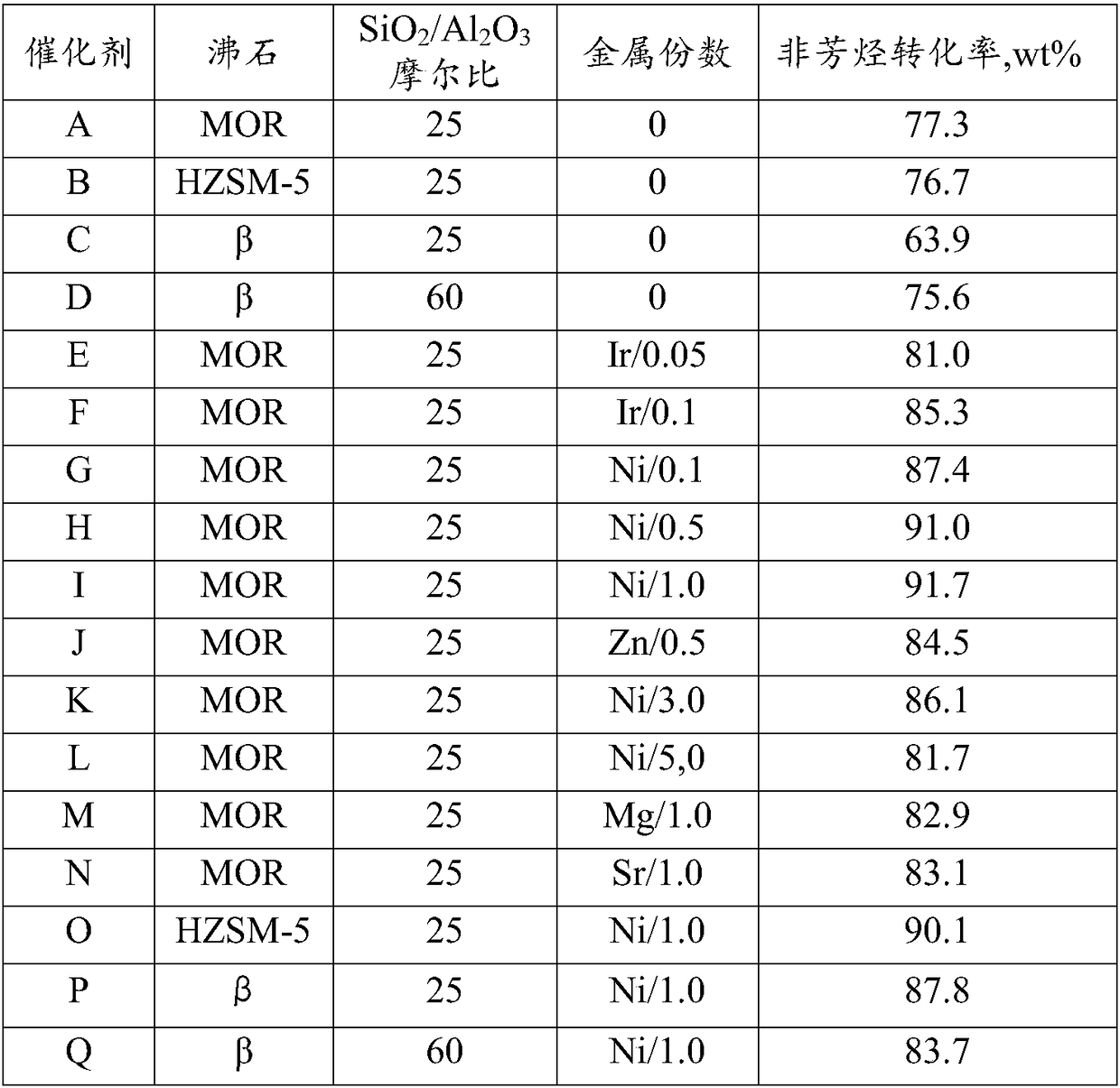Method for selectively cracking non-aromatic hydrocarbon
A non-aromatic and selective technology, applied in hydrocarbon cracking to produce hydrocarbons, chemical instruments and methods, molecular sieve catalysts, etc., can solve the problems of poor selectivity and low activity of cracking catalysts, and achieve the effect of reducing strong acid centers and improving cracking activity.
- Summary
- Abstract
- Description
- Claims
- Application Information
AI Technical Summary
Problems solved by technology
Method used
Image
Examples
Embodiment 1
[0033] SiO 2 / Al 2 o 3 25 mordenite 195g with γ-Al 2 o 3 Mix 107.1g evenly, then add dilute nitric acid and safflower powder, knead evenly, extrude into strips, roast to make a carrier, cut into pellets and place in an impregnation container. The metal precursor iridium chloride was dissolved in water, mixed evenly, impregnated with the surface of the carrier, dried at 120°C for 4 hours, and calcined at 500°C for 3 hours to obtain catalyst E.
[0034]In a fixed-bed reactor, install 20 grams of catalyst E, feed hydrogen, heat up to 400°C, purging for two hours for reduction activation, the reaction temperature is 400°C, the pressure is 3MPa, according to WHSV=2.5h -1 Working condition feed, hydrogen hydrocarbon molecular ratio 3.0. The raw material weight composition is toluene / methylcyclohexane=99.5 / 0.5. The catalyst reaction performance results are shown in Table 1. The catalyst reaction remained stable for 300 hours.
Embodiment 2
[0036] SiO 2 / Al 2 o 3 25 mordenite 195g with γ-Al 2 o 3 Mix 107.1g evenly, then add dilute nitric acid and safflower powder, knead evenly, extrude into strips, roast to make a carrier, cut into pellets and place in an impregnation container. Catalyst F was obtained by dissolving the metal precursor iridium chloride in water, mixing evenly, impregnating the surface of the carrier, drying at 120°C for 4 hours, and calcining at 500°C for 3 hours.
[0037] In a fixed-bed reactor, install 20 grams of catalyst F, feed hydrogen, raise the temperature to 400 ° C, purging for two hours for reduction activation, the reaction temperature is 400 ° C, the pressure is 3 MPa, according to WHSV = 2.5h -1 Working condition feed, hydrogen hydrocarbon molecular ratio 3.0. The raw material weight composition is toluene / methylcyclohexane=99.5 / 0.5. The catalyst reaction performance results are shown in Table 1. The catalyst reaction remained stable for 300 hours.
Embodiment 3
[0039] SiO 2 / Al 2 o 3 25 mordenite 195g with γ-Al 2 o 3 Mix 107.1g evenly, then add dilute nitric acid and safflower powder, knead evenly, extrude into strips, roast to make a carrier, cut into pellets and place in an impregnation container. The metal precursor nickel nitrate was dissolved in water, mixed evenly, impregnated with the surface of the carrier, dried at 120°C for 4 hours, and calcined at 500°C for 3 hours to prepare catalyst G.
[0040] In a fixed-bed reactor, install 20 grams of catalyst G, feed hydrogen, heat up to 400°C, purging for two hours for reduction activation, the reaction temperature is 400°C, the pressure is 3MPa, according to WHSV=2.5h -1 Working condition feed, hydrogen hydrocarbon molecular ratio 3.0. The raw material weight composition is toluene / methylcyclohexane=99.5 / 0.5. The catalyst reaction performance results are shown in Table 1. The catalyst reaction remained stable for 300 hours.
PUM
 Login to View More
Login to View More Abstract
Description
Claims
Application Information
 Login to View More
Login to View More - R&D
- Intellectual Property
- Life Sciences
- Materials
- Tech Scout
- Unparalleled Data Quality
- Higher Quality Content
- 60% Fewer Hallucinations
Browse by: Latest US Patents, China's latest patents, Technical Efficacy Thesaurus, Application Domain, Technology Topic, Popular Technical Reports.
© 2025 PatSnap. All rights reserved.Legal|Privacy policy|Modern Slavery Act Transparency Statement|Sitemap|About US| Contact US: help@patsnap.com

